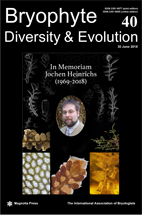Abstract
The recent rediscovery of the rheophytic endemic Ceratolejeunea temnantha ~130 years after its original description, on the upper Rio Negro in the Brazilian Amazon, has enabled the assessment of its enigmatic phylogenetic position, estimates of its divergence time, and updates on its distribution and potential habitat threats. Phylogenetic analyses strongly supported its placement in the genus Ceratolejeunea in a geographically disparate clade including a Madagascar endemic C. saroltae and two Neotropical taxa, C. confusa and C. caducifolia. Divergence time estimates date the clade’s stem age to the late Miocene (8.92 [HPD: 12.39–6.04] Ma) offering further evidence that the evolution of rheophytes in northern South America is correlated with the expansion of cryptogams into novel ecological niches promoted by dramatic landscape changes during the Miocene. Major geomorphological and hydrological transformations contributing to such diversification are most likely the changing dynamics of the inundated mega lake system to the establishment of the Amazon River due to the Andean orogeny and the subsequent cessation of marine influences in the north-western portion of the Basin. Until recently, this rheophyte of seasonally inundated black-water forests was only known from its type collection from the Rio Negro near São Gabriel da Cachoeira (Brazil) as described by Richard Spruce in 1884. These new collections extend the distribution of this rare narrow endemic to the middle Rio Uaupés, a tributary of the upper Rio Negro near the Columbian border.

